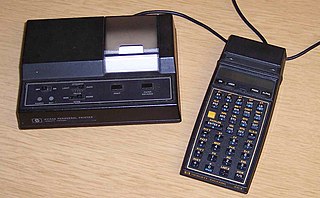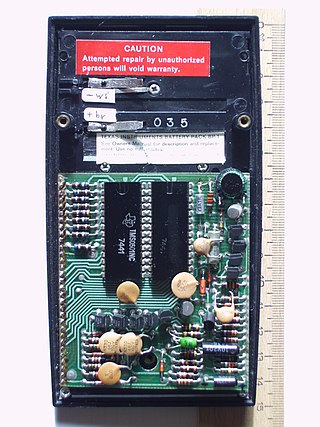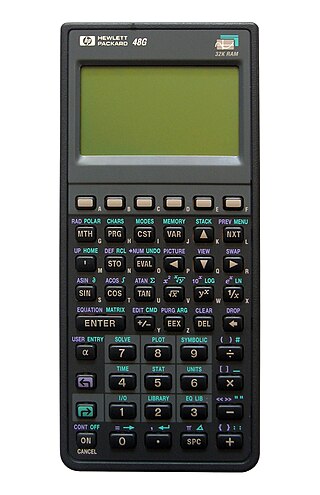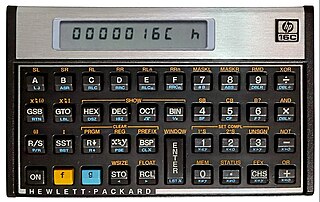
An electronic calculator is typically a portable electronic device used to perform calculations, ranging from basic arithmetic to complex mathematics.

The Sinclair Scientific calculator was a 12-function, pocket-sized scientific calculator introduced in 1974, dramatically undercutting in price other calculators available at the time. The Sinclair Scientific Programmable, released a year later, was advertised as the first budget programmable calculator.

A scientific calculator is an electronic calculator, either desktop or handheld, designed to perform calculations using basic and complex mathematical operations and functions. They have completely replaced slide rules as well as books of mathematical tables and are used in both educational and professional settings.

The HP-65 is the first magnetic card-programmable handheld calculator. Introduced by Hewlett-Packard in 1974 at an MSRP of $795, it featured nine storage registers and room for 100 keystroke instructions. It also included a magnetic card reader/writer to save and load programs. Like all Hewlett-Packard calculators of the era and most since, the HP-65 used Reverse Polish Notation (RPN) and a four-level automatic operand stack.
4-bit computing is the use of computer architectures in which integers and other data units are 4 bits wide. 4-bit central processing unit (CPU) and arithmetic logic unit (ALU) architectures are those that are based on registers or data buses of that size. A group of four bits is also called a nibble and has 24 = 16 possible values.

The HP-41C series are programmable, expandable, continuous memory handheld RPN calculators made by Hewlett-Packard from 1979 to 1990. The original model, HP-41C, was the first of its kind to offer alphanumeric display capabilities. Later came the HP-41CV and HP-41CX, offering more memory and functionality.

The HP-20S (F1890A) is an algebraic programmable scientific calculator produced by Hewlett-Packard from 1987 to 2000.

The HP-22S is an electronic calculator from the Hewlett-Packard company which is algebraic and scientific. This calculator is comparable to the HP-32S. A solver was included instead of programming. It had the same constraints as the 32S, lacking enough RAM for serious use. Functions available include TVM and unit conversions. Only single letter variable names are allowed. Marketed as a student calculator, the 22S uses infix notation rather than the reverse polish notation used on some higher-end HP calculators of the same era.

CORDIC, Volder's algorithm, Digit-by-digit method, Circular CORDIC, Linear CORDIC, Hyperbolic CORDIC, and Generalized Hyperbolic CORDIC, is a simple and efficient algorithm to calculate trigonometric functions, hyperbolic functions, square roots, multiplications, divisions, and exponentials and logarithms with arbitrary base, typically converging with one digit per iteration. CORDIC is therefore also an example of digit-by-digit algorithms. CORDIC and closely related methods known as pseudo-multiplication and pseudo-division or factor combining are commonly used when no hardware multiplier is available, as the only operations they require are additions, subtractions, bitshift and lookup tables. As such, they all belong to the class of shift-and-add algorithms. In computer science, CORDIC is often used to implement floating-point arithmetic when the target platform lacks hardware multiply for cost or space reasons.

The SR-50 was Texas Instruments' first scientific pocket calculator with trigonometric and logarithm functions. It enhanced their earlier SR-10 and SR-11 calculators, introduced in 1973, which had featured scientific notation, squares, square root, and reciprocals, but had no trig or log functions, and lacked other features. The SR-50 was introduced in 1974 and sold for US$170. It competed with the Hewlett-Packard HP-35.

HP calculators are various calculators manufactured by the Hewlett-Packard company over the years.

The Jornada was a line of personal digital assistants or PDAs manufactured by Hewlett-Packard. The Jornada was a broad product line that included Palm-Size PCs, Handheld PCs, and Pocket PCs. The first model was the 820, released in 1998, and the last was the 928 model in 2002 when Compaq and HP merged. The Jornada line was then succeeded by the more popular iPAQ model PDAs. All Jornada models ran Microsoft Operating Systems that were based on Windows CE.

The HP-25 was a hand-held programmable scientific/engineering calculator made by Hewlett-Packard between early January 1975 and 1978. The HP-25 was introduced as a cheaper alternative to the ground-breaking HP-65.

The HP-71B was a hand-held computer or calculator programmable in BASIC, made by Hewlett-Packard from 1984 to 1989.

The HP-16C Computer Scientist is a programmable pocket calculator that was produced by Hewlett-Packard between 1982 and 1989. It was specifically designed for use by computer programmers, to assist in debugging. It is a member of the HP Voyager series of programmable calculators. It was the only programmer's calculator ever produced by HP, though many later HP calculators have incorporated most of the 16C's functions.

The Sinclair Cambridge was a pocket-sized calculator introduced in August 1973 by Sinclair Radionics. It was available both in kit form to be assembled by the purchaser, or assembled prior to purchase. The range ultimately comprised seven models, the original "four-function" Cambridge, which carried out the four basic mathematical functions of addition, subtraction, multiplication, and division, being followed by the Cambridge Scientific, Cambridge Memory, two versions of Cambridge Memory %, Cambridge Scientific Programmable and Cambridge Universal.

The HP 35s (F2215A) is a Hewlett-Packard non-graphing programmable scientific calculator. Although it is a successor to the HP 33s, it was introduced to commemorate the 35th anniversary of the HP-35, Hewlett-Packard's first pocket calculator. HP also released a limited production anniversary edition with shiny black overlay and engraving "Celebrating 35 years".

The HP-55 was a programmable handheld calculator, a lower-cost alternative to the HP-65. Introduced by Hewlett-Packard in 1975, it featured twenty storage registers and room for 49 keystroke instructions. Its outward appearance was similar to the HP-65, but its silver band went through between the display and the keyboard like HP-45, and the functions of some keys were different from HP-65, and it did not have a magnetic card reader/writer. Like all Hewlett-Packard calculators of the era and most since, the HP-55 used Reverse Polish Notation (RPN) and a four-level automatic operand stack.

France Rode was a Slovenian engineer and inventor best known for his work on the HP-35 pocket calculator. He was one of the four lead engineers at Hewlett-Packard assigned to this project.

The HP-67 is a magnetic card-programmable handheld calculator, introduced by Hewlett-Packard in 1976 at an MSRP of $450. A desktop version with built-in thermal printer was sold as the HP-97 at a price of $750. Collectively, they are known as the HP-67/97.




















